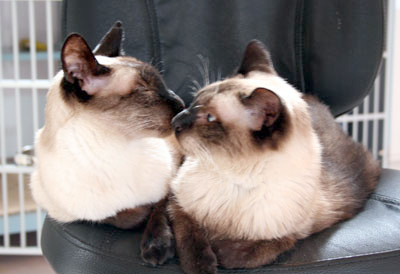So you’re getting a new cat! How very exciting! Once upon a time, I combined households with hubby #1, bringing his cat, Broadway, over to my house and plopping her down in a room with my two cats. All three were laid back; I figured they’d sniff each other and be wonderful friends from there on in. What ensued was a fur-flinging, pee-spraying fight that lasted almost 10 years. They never got over that (WRONG) introduction and poor Broadway lived out her life in misery because we didn’t introduce them the right way. Don’t make that mistake!
Whether or not you have other animals, it is highly likely that your new cat may be a bit overwhelmed by the change of scenery, particularly if it’s past kittenhood. Cats like small places, so before bringing your new family member home, set up a room that can be the ‘safe room’ for your cat. A place to hide (under the bed is fine), food and water, and of course the litterbox are the main components. The chosen room should be a quiet one; ideally a space where you can easily spend time (even if it’s sleeping) – so a bedroom, den, study or home office works well. Make sure that the food, water and litterbox* are fairly close to wherever you suspect the cat may hide and that they don’t have to cross an enormous spanse of scary space to get to them. Ideal isolation time (if you have other animals) is 10-14 days, just in case your new cat breaks with a sniffle or a bout of loose stools from the stress of the new environment (you don’t want any existing animals to catch anything). If you do need a vet visit (and it’s always a good idea with a new family member), it’s ideal to make your appointment at or around the ten day mark, allowing you an opportunity to observe and get to know your cat. This way you can provide information on eating, drinking and litter habits to the vet. (You definitely want a vet visit in place before your cat meets any existing pets). Rushing off to the vet on day one can be done, but doesn’t allow you to provide any feedback as to how the cat is adjusting. Obviously if your cat is sickly or comes from a situation where it hasn’t been vetted, an early vet visit will be prudent.
Even if you don’t have other animals, you will know your cat is ready to explore when you walk into the safe room and your cat is standing there looking at you expectantly, as if, surely, there must be more to your home than this small space. Don’t rush this, there’s no hurry, ensuring your cat is good and comfortable with you as well as with the smells and sounds of your home is key before giving them the entire house to explore. I always liken this time to a person’s first ever visit to a large city: New York City for example. Imagine you are a country person with no experience in a metropolitan area – you could easily be overwhelmed by the sights, sounds, and even smells of such a large place. For a cat, your home may be similarly overwhelming, so take it slow.
If you have other animals, you can help the integration process during the 10 days by exchanging bedding, the litterbox, even by placing the carrier your cat used out in the general population so that it can be inspected. Remember that animals and particularly cats work by smell, so providing every opportunity to smell the new member without actually interacting with them is ideal. Basically you want to wait for two things – first, existing pets appear bored by the fact there is a new addition behind closed doors, and secondly, the new pet is showing comfort within their safe space – laying on the bed, acting relaxed, interacting with you, etc.
When it’s time to integrate, depending on how many other pets you have, you may want to introduce them one at a time, rather than the entire slew, so that there is no opportunity for gang behavior. I have always been a fan of simply leaving the door to the safe room open, as if I did it by mistake, and letting nature take its course. Again, depending on the size of your home, you’re not going to do this if you live in a massive place and your new cat is spooked. You may need to gradually increase their comfort zone by closing off extraneous doors as you allow your cat the opportunity to explore the new digs.
Patience is really key. You are working here to build a long-term relationship between you and your new cat and your new cat and the existing family members, both furry and human. Cats who are overwhelmed need time to decompress – they are unlikely to want to be held, cuddled, carried around until they trust you – no kissing on that first date. If you rush things, forcing yourself or others on the cat before they are ready, establishing trust and bonding between family members is going to be so much more difficult to attain. There is no hurry – relationships are not built overnight. Failure to integrate properly often results in rivalries that cannot be overcome, as was true for poor Broadway. She spent her entire life tormented by the other cats in the household and, in hindsight, would have been a much happier cat if we had found her a quieter home. But that’s a blog entry for another time.

*Cats should eat and drink within the first 48 hours of getting home. Remember that production in the litterbox means something is going in. If they are so frightened they are not eating or drinking, it’s time for a vet visit asap.

So very, very important, and what luck if it all works out after 14 days